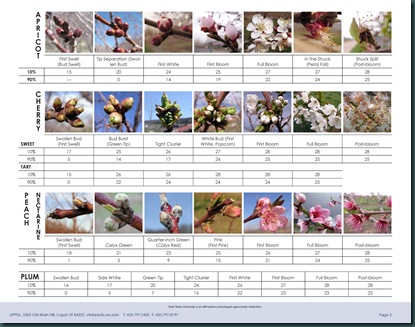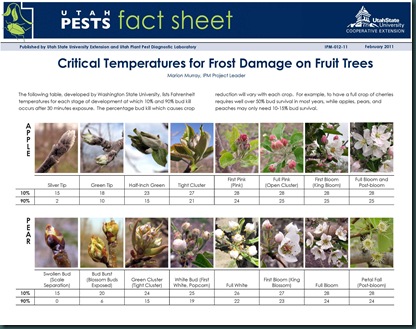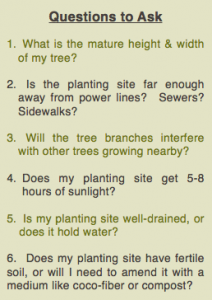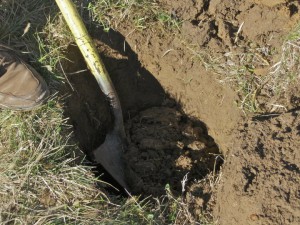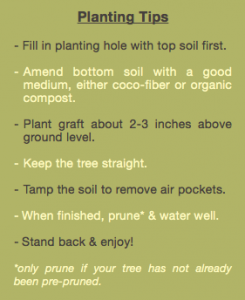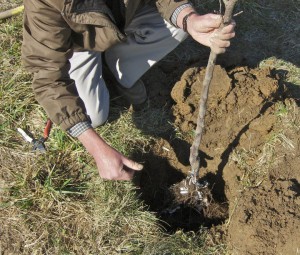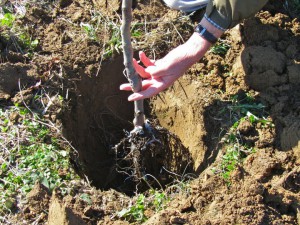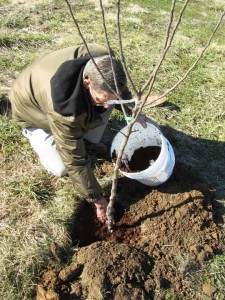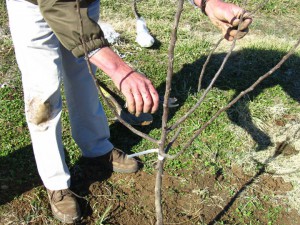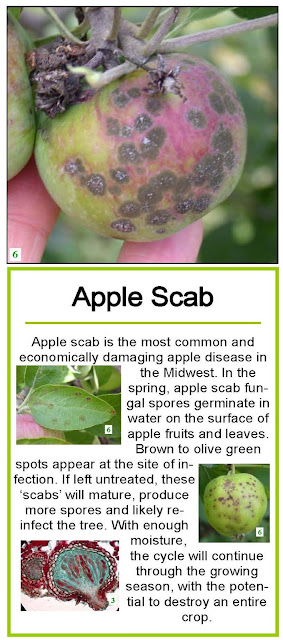
We are now officially emerging into the apple scab
season as green tip and 1/4" green leaf tissue is seen on the apple
trees. Apple
scab is the most prevalent and most damaging disease to apples we have
in the Midwest and pretty much all apple growing locations east of the Rocky Mountains. At this point, scab sprays should be applied according to the Apple Spray Guide found in "Managing Pests in Home Fruit Plantings". In the spring, once temperatures rise above the 42 degree or
so mark, apple scab fungal spores can germinate in water on the surface
of apple tree leaves and eventually, on the fruit itself. The water
or moisture that is on the leaves is termed "leaf wetness". The spores
will germinate once the leaves are wet for a certain period of time at
temperatures above 42 degrees. On the leaves, olive green to brown spots
appear on the site of the infection. If the leaves have not been
protected from this "primary" scab infection, the spores will mature and
produce more spores during "leaf wetness" periods and move onto the
apples where they form a "scab" like lesion, if the fruit is not
protected. We call the lesions on the apples "secondary" scab. With
enough moisture (leaf wetness), the cycle continues throughout the
growing season and destroys the crop. Each leaf wetness event at the
proper temperature that occurs during the early growing season is called
and infection period.
Managing Apple Scab
The
apple scab fungus survives in dead leaves on the ground and over
winters there on the leaves. A lack of spring rains can reduce its
importance, but as a rule, apple scab
requires yearly spray treatments. And, ornamental
crab apple trees are also hosts. As plant parts mature and the weather gets
warmer, susceptibility to this disease decreases, usually in late June,
but pinpoint scab can
occur during extended periods of moisture during summer. The main
objective in scab management is the reduction or prevention of
primary infections in spring. Extensive primary infections result in
poor fruit set and make scab control during the season more difficult.
If primary infections are successfully controlled, secondary infections
will not be serious. The key to success in scab control is exact timing
and full spray coverage. Wet periods, temperature, and relative humidity
are
important factors. Because scab control often is part of a combination
treatment aimed at other diseases and insect control, choice of
materials and timing are also extremely important.
How Can an Infection Period be Determined?
Apple scab infection periods can be predicted based on temperature and moisture (leaf wetness)
conditions. The Mills Table below, derived from research by Mills and La
Plante, gives hours needed at various temperatures under constantly wet
conditions for primary spores (ascospores) to cause infection in spring.
This system for forecasting scab and timing sprays has been validated
for apple-growing regions in the Midwest.
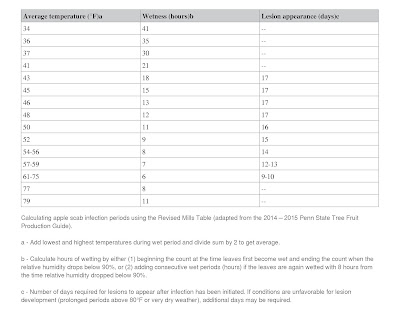 |
| How to use the table: Figure the average temperature for the rain
period by adding the maximum and the minimum temperatures and dividing
by 2. If wet periods are intermittent, total their duration until there
is a period of at least 6 hours of continuous dryness. You will need a
wetness recorder to do this efficiently. If the dry period is sunny, and
drying is quick and thorough, it is assumed that 6 hours after the
trees have dried, the danger is passed. If drying is slow, and humidity
remains high, then the 6-hour dry period is extended by a safety margin
of 3 to 4 hours. |
|
To Spray or Not To Spray

 Monitoring
for apple scab can be quite complicated for the home grower. But there
is an alternative. Unless wetness periods are being monitored as
outlined in the section
above, you can simply apply protective or eradicant fungicides at
regular intervals beginning with green tip. Spraying should be done
every 7 to 10 days, depending on the number of rain events between
sprays. If there are no rain events between sprays, a single protectant
spray will last at least 10 days but not more than 14 days, based on
the product's label directions. You will need to make sure that your
trees and fruit are protected prior to any rain event if you are going
to use only a protectant. A good protectant is Captan or Mancozeb.
But, a protectant can lose its effectivness after 2" of rain, so you
also want to keep an eradicant on hand like a myclobutanil, which is
available as Spectracide Immunox. A protectant like Captan has to be applied prior to a rain event. If no protection is available during the wetting event, then only an eradicant like Immunox
can be applied that has a reach back of at least 48 hours. That means
that it can still have an effect on the scab pathogen for up to 48 hours
after a wetting event. A good option is to actually use both a
protectant and an erdicant at the same time, like Captan mixed with
Immunox, which will give you both protection and eradicant action after a
wetting event. Be sure to monitor wetness periods throughout the spring to insure that trees are always adequately protected.
Monitoring
for apple scab can be quite complicated for the home grower. But there
is an alternative. Unless wetness periods are being monitored as
outlined in the section
above, you can simply apply protective or eradicant fungicides at
regular intervals beginning with green tip. Spraying should be done
every 7 to 10 days, depending on the number of rain events between
sprays. If there are no rain events between sprays, a single protectant
spray will last at least 10 days but not more than 14 days, based on
the product's label directions. You will need to make sure that your
trees and fruit are protected prior to any rain event if you are going
to use only a protectant. A good protectant is Captan or Mancozeb.
But, a protectant can lose its effectivness after 2" of rain, so you
also want to keep an eradicant on hand like a myclobutanil, which is
available as Spectracide Immunox. A protectant like Captan has to be applied prior to a rain event. If no protection is available during the wetting event, then only an eradicant like Immunox
can be applied that has a reach back of at least 48 hours. That means
that it can still have an effect on the scab pathogen for up to 48 hours
after a wetting event. A good option is to actually use both a
protectant and an erdicant at the same time, like Captan mixed with
Immunox, which will give you both protection and eradicant action after a
wetting event. Be sure to monitor wetness periods throughout the spring to insure that trees are always adequately protected.
More About Fungicides
Fungicides
can be contact fungicides or penetrant fungicides and non-systemic,
locally systemic or systemic. Mobility describes fungicide movement
after it is applied to a plant. To understand differences in mobility,
it’s important to know the difference between absorption and
adsorption.
Fungicides
that can be taken up by the plant are absorbed. Fungicides that adhere
in an extremely thin layer to plant surfaces are adsorbed. Because
fungicides are either adsorbed or absorbed, they have two basic forms of
mobility: contact and penetrant. Regardless of the type
of mobility that a fungicide possesses, no fungicide is effective after
the development of visible disease symptoms. For that reason, timely
fungicide application before establishment of the disease is important
for optimal disease management.
Contact
fungicides are adsorbed and considered non-systemic. They are
susceptible to being washed away by rain or irrigation, and most (but
not all) do not protect parts that grow and develop after the product is
applied. Captan is one such contact fungicide.
Penetrant
fungicides are absorbed, so they move into plant tissues, and penetrate
beyond the cuticle and into the treated leaf tissue itself. There are
various kinds of penetrants, characterized by their ability to spread
when absorbed by the plant. They can be locally systemic, penetrating
leaf tissue only or systemic, moving beyond the leaf tissue. Systemic
fungicides can be further subdivided based on the direction and degree
of movement once they have been absorbed and translocated inside the
plant. Immunox is a penetrant that is xylem mobile, therefor, not
totally systemic or amphimobile.
 |
©Janna Beckerman, Department of Botany and Plant Pathology, Purdue University
|
Xylem-mobile fungicides (also called acropetal penetrants ) move upward from the point of entry through the plant’s xylem.
Amphimobile fungicides (also called true systemic penetrants) move throughout the plant through its xylemand phloem.
Locally systemic fungicides have limited translocation from the application site
Translaminar
fungicides are absorbed by leaves and can move through the leaf to the
opposite surface they contact, but are not truly systemic and do not move
throughout the plant.
In summary, systemic fungicides work
by becoming absorbed into the plant tissues and protecting the plant
from fungal diseases as well as ridding the plant of any existing
diseases. Some systemic fungicides are locally systemic, meaning that
the chemicals aren't transmitted very far from the application site on
the plant. Other systemic fungicides are applied to and absorbed up
through the roots, moving throughout the rest of the plant. Eradicant
fungicides can have systemic action, depending on which chemistry is
chosen. Some are translocated within
the host tissue and are able to kill the scab fungus up to a certain
length of time after infection occurs. This is called the kickback or
reachback
period. Because kickback periods may change, always check the label for
the most recent information. Kickback is calculated from the beginning of an infection period, as determined by the Mills and La Plante table.

